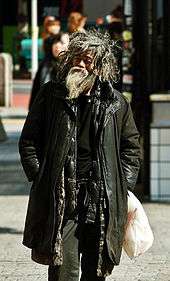Poverty in Japan
Japan, despite being the world's third largest economy, has a rising problem of poverty. Poverty figures are very hard to find in Japan. Because of its reputation as a developed country, it is generally assumed that the levels of poverty are relatively low. However several media reports contrast this.
Measure of poverty
In Japan, relative poverty is defined as a state at which the income of a household is at or below half of the median household income.[1] According to Organization for Economic Co-operation and Development (OECD), the mean household net-adjusted disposable income for Japan is $23,458. This income is in fact higher than OECD member state average of $22,387.[2] The method used for estimation of poverty in Japan is same as that used in the U.K.. Japan's welfare ministry, put forward a request in 2012 national budget to come up with a new poverty index. This request was submitted so that the new index could include important factors affecting poverty, namely, health, food, clothing and living conditions. The new index is expected to provide a better insight into the lives of poor in Japan and the factors affecting them.[3] In the United States, a different method is used for estimation of poverty.[4]
Reports and findings
Unlike in other countries, only a few indicators of poverty are visible to people despite the fact that a significant portion of the population is below poverty.[3]
Domestic reports
2009
In October 2009, Japan's Labor Ministry released a report which stated that almost one in six Japanese, which would be 20 million people, lived in poverty, in 2007. This revelation was met with shock and surprise among the Japanese people.[5]
2013
In 2013,the Japanese government recorded relative poverty rates of 16% which was defined as the share of the population living on less than half the national median income. This was the highest on record.[6]
Demographics
Another study showed that 1 out of 3 Japanese women in the age group of 20-64, and those who live alone, were living in poverty.[7]
International reports
Several international organisations have conducted surveys and studies in Japan to estimate the poverty.
OECD findings
OECD reported in July 2006 that Japan is native to high rates of relative poverty. OECD's another report stated that Japan was second worst in poverty among the OECD member nations, in the mid 2000s.[1] The OECD, in April 2011, placed Japan at the 29th position out of 34 member nations, in the list of percentage of population living in poverty. With 15.7 percent of people in poverty, Japan was above the average percent of 11 among the OECD member states. Japan's 15.7% is above than countries which have less resources and are less developed than Japan, namely, Slovak Republic (6.5%), Slovenia (7.2%), and Poland (10.1%) Poverty rate is increasing at an alarming rate of 1.3% in Japan, since 1985. The poverty rate increase average is 1.0% annually for all other OECD member nations.[3][8] The OECD report places Japan just below U.S.A., which has a 17.3% poverty measure, statistics indicate that U.S.A. has been cutting down on poverty, by a 0.7% decrease since 1985.[8]
Japan's Working Poor
Unlike several other modern countries, Japan has no official poverty line, making it difficult to get accurate figures on those suffering impoverished conditions. Instead Japan measures poverty based on a "minimum standard of living" calculated using median income, the OECD index and other factors differing from prefecture, to prefecture. Still, it is estimated that in 2006, when measuring on an individual basis using the Employment Status Survey, that 8.2% of regular employees made little enough to be considered working poor. Several factors have been found to be correlated with the working poor including single-parent households, shortcomings of the Public Assistance System, unstable employment and minimum wage insufficient to cover a minimum standard of living. Irregular workers tend to be members of the working poor and are often the result of Japanese companies restructuring. These workers also tend to be homeless, and reside in areas generally away from the public eye with well known homeless "villages" existing such as Hakenmura, a homeless village compared by scholar Toru Shinoda to the United States' Hooverville. Members of these communities tend to become day laborers, who by their nature are irregular workers. [9][10]>[11]
Saitama starvation case
On February 20, 2012 the death of a family of three people was reported from Saitama due to starvation-an elderly couple and their 39-year-old son. The family couldn't afford to pay the rent and electricity had been cut off.[8] Unable to pay for heating, hypothermia is also suspected to be the cause of their death.[3]
See also
References
- 1 2 Rising poverty in Japan, Japan Times.
- ↑ Income, OECD Report.
- 1 2 3 4 Poverty in Japan: Shadowy figures | The Economist
- ↑ Statistics on Poverty
- ↑ Japan Tries to Face Up to Growing Poverty Problem
- ↑ Struggling, The Economist, 4th April, 2015.
- ↑ Poverty a growing problem for women, Japan Times.
- 1 2 3 Poverty in Japan – The Global Intelligence
- ↑ Yuki Sekine (2008). "The Rise of Poverty in Japan: The Emergence of the Working Poor" (PDF). The Japan Institute for Labour Policy and Training. Retrieved 22 November 2016.
- ↑ Julia Obinger (2009). "Working on the Margins: Japan's Precariat and Working Poor". Electronic Journal of Contemporary Japanese Studies. Retrieved 25 November 2016.
- ↑ Toru Shinoda (2009). "Which Side Are You On?: Hakenmura and the Working Poor as a Tipping Point in Japanese Labor Politics" (PDF). The Asian-Pacific Journal. Retrieved 25 November 2016.
